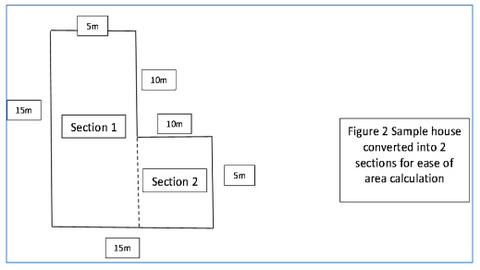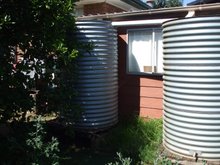Next on the list – Measuring your Greywater
Grey water is on the “plus” side of the equation because although it has already been used once, to clean clothes or to clean you or whatever, it can still be pressed into service to carry out other functions, like watering the garden or flushing toilets. The figures for shower, bath and washing machine can just be transferred from where you calculated them in the usage part of the audit but the laundry sink may have hand washing water or other things as well so either estimate or put the plug in for twenty four hours and then use a calibrated jug to empty it and record the amount.
Calculating your Potential Rainwater Harvest
In the suburban backyard it is highly unlikely that you will be able to put in a dam or a well to use as water sources but you can hold and store the water coming off your roof, but how much could that be? Now we will work it out.
If you have a rain gauge and are pedantic about keeping your records, the first entry in this section will be easy, but if not (and I have to put my hand up here!) go to the Bureau of Meteorology (BOM) website and find the rainfall monitoring station closest to where you live. Check the records for as far back as you can and at this stage we are only interested in the yearly total. Collect as many yearly totals as you can and then average them and record them in the “annual rainfall” box. It pays to be a little circumspect with the data from the BOM, especially the older data because if it seems that your yearly rainfall is decreasing it might be worth only averaging more recent data so that you get a bit more conservative (or perhaps realistic) figure.
Calculating Catchment Area
It is quite likely at the moment that all rain falling on your property makes its way to the water table or to the sea with not much happening in between, but what we want to do is to capture it and make it do some work on the way. In that way we can replace some of the water your draw from the town water system, which has been filtered, disinfected and pumped to your house at considerable energy cost with water harvested on site and little or no energy cost.

So how much could you harvest? The first thing is to work out the area of every roof surface that you have which is capable of shedding water, which means your house, being most probably the largest structure on your land, garage, covered decks, sheds, greenhouses or whatever. It helps if you have a plan view of your block that includes all structures on the block.

Calculating Roof Area of Figure 2
Area of Section 1 = 15m x 5m =75m2
Area of Section 2 = 5m x 10m = 50m2
Total area or house roof = 75m2 + 50m2 = 125m2
Take a measuring tape and a friend (believe me this is much easier with a friend!), and measure the sides of each of the structures on your block, recording the measurements on the plan in metres. You can now work out the area of each structure, length multiplied by breadth. If any of your structures are not regular you may need to divide them up into squares or rectangles, multiply them out and then add them together to give total area (see figures 1 and 2 above). We had to do that with our house because one of the bedrooms just forward and, let’s face it, few houses these days are a nice, neat square or rectangle.
Calculating the Potential Rain Water Harvest and Storage Requirements
Once all of your areas are calculated, put them on the form and then add them up to give the total area on your block that can be used to harvest rain water. You can then calculate the total possible amount of rainwater you can harvest in a year by multiplying the catchment area by the yearly rainfall figure from the BOM, which will give you an answer in litres. Now take 15% of that figure to allow for incomplete collection (for whatever reason) of the rainwater falling on your site, then record that on the audit form.

Now enter the figures for daily and yearly water consumption into the form and then go back to be BOM website and look through the rainfall records for your area and identify the longest number of rainless days that you can find. Then multiply the number of rainless days by the daily consumption and this will give you an idea of how much water you will need to store to make it through a drought. Adding an allowance of 20% extra storage will provide extra water storage in case of reduced rainfall or increased consumption.

From the above calculations it can be seen that reducing your water consumption means that there is less rainwater storage required to get you through the dry times.
In the second last line of the form add in the volume of any existing water tanks on your site and by taking that figure away from the one above it you will get an idea of how much rainwater storage you will need to install.
Using the Information
OK, now that you have gone through all of this rigmarole, what do we do with the information? The most obvious thing is to use it to put plans in place to install water tanks to cover at least as much as the figure on the bottom line of the form. Having said that, there are two sides to the water “debate”, storage is one side but the other is consumption and you can use the information turned up by this audit to help you reduce your water consumption and thereby reduce the amount of water your need to store. (how much water you want to store is another matter!)
The audit will help you to identify what the big water consumption items for you are; maybe you have a huge top loading washing machine and can reduce your consumption by replacing it with a front loader or maybe it will show up a whole lot of smaller areas where you can reduce consumption.
For us it was watering the fruit trees etc in the front yard. We have a large tank in the front yard and it is plumbed into the back through a 12 volt pump so we can water the veggies easily, but we did not use the tank to water things in the front yard. After some quiet thought and discussion with my partner in the sustainable life we identified a couple of problems –
- While I had put a tap in the plumbing from the tank there was no attached hose, which meant removing the existing one from the front (mains water) tap and putting it onto the tank tap. The fix was to get another hose and nozzle that could remain fitted to the tank tap.
- The switch for the pump is in the garage so it means that you have to turn on the valve on the tank, walk to the garage and turn on the pump, then walk back to the tank to use the hose. The easier you make things to use, the more they will be used so the next fix is to install a switch next to the tank.
- Lastly, to make things more efficient, I need to install a drip watering system in the front yard.
So you can see that by carrying out a water audit you can get a handle on not only on how much water storage you need, but also where your water consumption is highest, so that you can know where to target to get the best reduction. It worked for me!


